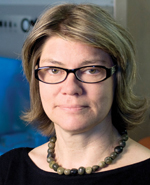July 8, 2008 - By Krista Conger

Renee Reijo Pera
School of Medicine researchers received about $5.6 million on June 27 from the California Institute for Regenerative Medicine in awards designed to support the creation of new pluripotent human stem cell lines. All four of the medical school's applicants were funded.
The researchers received multiyear grants of about $1.4 million each as part of CIRM's newest round of awards. The awards support two types of research. One is the creation of new human embryonic stem cell (hESC) lines from excess or discarded early-stage human embryos created by in vitro fertilization. Another is the derivation of new pluripotent human stem cell lines either through a technique called somatic cell nuclear transfer or by modifying neonatal or adult cells to render them pluripotent. These 'reprogrammed' cells are called induced pluripotent stem cells, or iPSCs. Grant reviewers gave special consideration to those types of research unlikely to receive federal funding.
Pluripotent stem cells can both renew themselves and become nearly any type of cells in the body. Unlike neonatal or adult cells, which have begun to specialize in certain types of cells or tissues, embryonic stem cells start with a genetic blank slate and are therefore considered to be the most reliable type of pluripotent cells for use in research and potential clinical applications.
However, the use of human embryos can present an ethical dilemma for many people. The creation of new pluripotent cells from neonatal or adult tissues, although likely to require additional modification, would circumvent many ethical issues. It may also allow the creation of personalized stem cell lines to treat specific individuals struggling to overcome injury or disease.
CIRM's oversight committee granted 16 awards totaling $23 million out of about 50 applications from 38 non-profit institutions and 12 for-profit companies. With the latest round of grants, Stanford's total funding from CIRM amounts to about $90 million, more than any other institution.

Julie Baker
'CIRM continues to show its confidence in Stanford's faculty and facilities,' said Irving Weissman, MD, director of the Stanford Stem Cell Biology and Regenerative Medicine Institute. 'We are extremely pleased and proud of the researchers who are the recipients of this latest round of funding.'
Stanford researchers who were awarded the latest grants include:
Renee Reijo Pera, PhD, director of the Human Embryonic Stem Cell Research and Education Center in Stanford's stem cell institute. Unlike many adult cells, which require reprogramming through the introduction of genes to achieve pluripotency, recently derived unmodified spermatogonial stem cells (SSCs) from mice have been shown to be very similar to embryonic stem cells. Reijo Pera plans to isolate matched pairs of SSCs and iPSCs from at least three men and to compare their molecular, genetic and developmental characteristics with those of recently derived hESC lines that are not eligible for federal funding. This approach will allow the first direct comparison of the research and clinical potential of two types of genetically identical pluripotent cell lines from the same men. Total funds awarded: $1.41 million.
Michael Longaker, MD, MBA, deputy director of Stanford's stem cell institute and director of the Program in Regenerative Medicine. Longaker and Eric Chiao, PhD, clinical instructor of obstetrics and gynecology, propose to compare the differentiation and functional potential of iPSCs with that of hESCs. Another arm of their studies involves the creation of disease-specific stem cell lines for Marfan Syndrome and Loeys-Dietz Syndrome, which affect both bone and cardiovascular development in those with the diseases. Total funds awarded: $1.42 million.
Michele Calos, PhD, professor of genetics. Calos plans to investigate ways to reprogram adult cells to become pluripotent without the use of retroviruses. All currently available iPSCs were created with these viruses, which can cause cells to grow abnormally or become cancerous. These cell lines are therefore unsuitable for clinical use. Calos has developed a novel method for introducing the genes necessary for reprogramming into one defined chromosomal location that will not adversely affect the cells. She will use this method to create a variety of mouse and human iPSCs, which she will test for their ability to differentiate into a variety of tissues in vitro and to cure a genetic disorder in a mouse model. Total funds awarded: $1.41 million.
Julie Baker, PhD, assistant professor of genetics. Baker plans to create more than 15 new hESC lines containing mutations that affect the ability of the cells to become neural tissues in the brain and spinal cord. Many of these mutations are associated with disorders that cause mental retardation in children, including Hurler syndrome, Fragile X syndrome, Tay-Sachs disease and Canavan disease. New hESC lines of these disorders will allow researchers to observe their development in the laboratory and to test potential therapies without requiring them to rely on post-mortem tissue. Total funds awarded: $1.42 million.
In the same round of funding, CIRM also announced 22 Disease Team Planning Awards of up to $55,000 each, for a total of about $1.1 million. This would support the assembly of multidisciplinary teams of scientists to plan how best to develop stem cell therapies or diagnostics for specific diseases or injuries. The planning awards are meant to provide support for groups intending to apply for the multiyear Disease Team Research Awards to be distributed next year. Two Stanford researchers received these planning awards: Thomas Rando, MD, PhD, associate professor of neurology and neurological sciences, was given $52,600 to assemble a team to treat muscular dystrophy; and Robert Robbins, MD, professor and chair of cardiothoracic surgery and director of the Stanford Cardiovascular Institute, received $55,000 to assemble a team to treat congestive heart failure.
CIRM was established in early 2005 after California voters passed Proposition 71. That proposition provided $3 billion over 10 years to fund stem cell research at nonprofit research institutions around the state. To date, the CIRM governing board has approved 206 research and facility grants totaling more than $554 million, making CIRM the largest source of funding for human embryonic stem cell research in the world.
About Stanford Medicine
Stanford Medicine is an integrated academic health system comprising the Stanford School of Medicine and adult and pediatric health care delivery systems. Together, they harness the full potential of biomedicine through collaborative research, education and clinical care for patients. For more information, please visit med.stanford.edu.